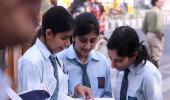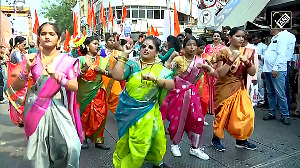India is trying to add 75,000 medical seats in five years as it also eyes to touch the WHO standard of one doctor for every 1,000 persons.

Around 30 per cent of the upcoming 10,000 medical seats in the country this year could be for post-graduate courses, industry insiders feel.
"Of the 10,000 seats announced to be added, 2,000 to 3,000 could be for the MD and DNB courses. The remaining 7,000 may be for MBBS," Gaurav Tyagi, career counsellor at Career Xpert said.
On the whole, India is trying to add 75,000 medical seats in five years as it also eyes to touch the WHO standard of one doctor for every 1,000 persons. Currently, the number is one doctor for 1,263 people.
PG seats in India have increased from 39,583 in FY19 to 73,157 in FY25 -- or around 33,574 seats in five years (according to the Economic Survey). In contrast, the aspirants have outnumbered the seats by a huge margin.
According to data from National Board of Education in Medical Sciences (NBEMS), which conducts NEET-PG, in 2023, there were 208,898 aspirants for 68,073 PG seats in India.
The focus on increasing quality medical education in the country comes when the Economic Survey highlighted the need to incentivise students to stay in India rather than go abroad.
"The limited number of PG seats in India and intense competition drive students to seek options abroad. Reservation policies also influence some students' decisions," Waseem Javed, founder and CEO, GetMeMbbs said.
Around 20,000 to 25,000 students move abroad annually to study medicine, with Russia, Kazakhstan, Ukraine, and Bangladesh among popular destinations.
However, upon returning to India to practice, often these students don't make the cut. As a result, they don't add up to the medical practitioners' workforce in the country.
'Only 16.6 per cent of 61,616 candidates who gave Foreign Medical Graduates Examination (FMGE) in 2023 got passing marks, indicating sub-par quality of medical education abroad, including lack of clinical training, the Economic Survey stated.
So, quality education is a focus area.

While increasing PG seats is the natural way to give aspirants an incentive to continue studies in India, Tyagi added that focus also needs to be put on better teaching faculties at medical colleges.
"Recently, 24 medical colleges in Uttar Pradesh were slapped with show-cause notices by the state's directorate of medical education and training for failing to meet the required faculty and infrastructure standards," he said.
India needs more medical graduates to not only bridge the rural-urban skew of availability of doctors, but also to man its ambitious projects like adding 4,500 daycare cancer beds across all district hospitals in three years.
It needs more PG graduates to take care of the growing cancer treatment needs. Incidence rate of cancer in India is 100.4 cases per 100,000 people.
"The country is already facing a shortage of specialists, especially in rural areas with only 4,413 such doctors available in the rural community health centres.
"This is against the sanctioned 21,964. It indicates a shortfall of 17,551 specialists, or 79.9 per cent," an official said.
Experts suggest that the availability of opportunities for medical education appear to be geographically skewed, apparent from the fact that 51 per cent of undergraduate seats and 49 per cent of postgraduate seats are in the southern states.
Similarly, doctor availability is heavily skewed in favour of urban areas with the urban to rural doctor density ratio being 3.8:1.
'It has been estimated that 75 per cent of dispensaries and 60 per cent of hospitals are in urban areas, where 80 per cent of doctors serve,' the Economic Survey added.
The official quoted above suggested that while many graduates and specialists prefer to practice in their home states or in major cities due to better amenities and professional opportunities, addition of seats presents a chance to enhance healthcare access in rural and underserved areas.
Moreover, there is also a skewed distribution of seats in favour of specialisations like radiology, dermatology, gynaecology, cardiology while specialities like oncology, psychiatry, geriatrics are neglected.
'Demand for postgraduate education is not restricted by the need for clinical practitioners, they are also crucial as faculty and trainers of the next generation,' the Economic Survey added.
'While we focus on increasing facilities for specialisations it is also necessary to maintain distribution across geographies and streams.'
Feature Presentation: Ashish Narsale/Rediff.com












 © 2025
© 2025